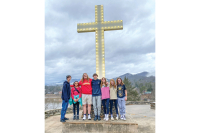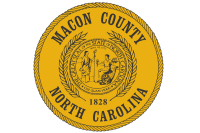Families sacrifice land for creation of the park
Gudger Palmer has never forgotten the fond memories of growing up in Cataloochee Valley. At 100 years old, one memory in particular brings a smile to his lips every time he returns to his old one-room school.
“That’s the place where the greatest love letter was ever written,” Palmer said. “I was sitting up front and someone punched me on the side. I reached back and saw it was a tablet. I opened it up, and there it was written with a pencil. I knew who it was from, that little girl sitting in the back. It said ‘I love you as good as apple butter.’”
Palmer was a grown man by the time the Great Smoky Mountains National Park claimed his homeplace in Cataloochee Valley. Palmer’s been asked many times, as have all Cataloochee descendents, what it was like to lose his land. At the annual Cataloochee reunion one year, Palmer asked the others how they respond to the inevitable question.
“I said ‘How can you tell other people just how you felt?’ and they said, ‘No, Gudger, you can’t tell other people,’” Palmer said. “There’s no way of getting across to you the feeling we have of losing Cataloochee.”
For Raymond Caldwell, 86, the hardest part of moving out was seeing how much it hurt his father.
“I think daddy carried that grief with him right on through the years, and he lived to be 92. He thought it was awful to have to give up their home and move out with not much compensation,” Caldwell said. “He loved that valley. He would go over there and stay in the campground by himself and walk on those trails up into his 80s.”
Related Items
More than 1,200 family farms were bought up for the park’s creation, uprooting roughly 7,000 people and forcing them to start anew. Over the decades, they returned to the spots where their homes once stood, watching as the forest slowly closed in, first claiming the fields and the garden plots. The foot paths they’d worn over time slipped back into the earth. And eventually, their old foundations were obscured by the sprouting wilderness. At least to the casual passerby.
“I always had in my mind a picture and could see where everything was,” said Commodore Casada, 99, who grew up on Deep Creek, a section of the park outside Bryson City, N.C. “I could tell where the barn was and the house and so on and so forth, but no one else could now.”
Even though Hattie Davis was only 6 years old when her family moved out of Cataloochee Valley, her memories are vivid, too.
“It is in my mind completely. I can still see the rail fence and the fat cattle and the fine horses and herds of sheep. The long straight rows of corn,” she said.
Every year since the park was created, Cataloochee families hold a reunion at their old church, the Palmer Chapel, which draws up to 600 descendents today. The reunion was bitter-sweet in the early years.
“They loved being with their family and friends again, but they would see their houses falling down and some would cry,” Davis said.
Davis grew up in the Caldwell house, one of the few buildings that was preserved by the park and offers a glimpse of the past. But when Davis walks through the house, through the kitchen where her mother made biscuits or the room she slept in as a little girl, the nostalgia is sometimes more than she can bear. Davis is even more heartbroken by the growing number of initials carved into the doors and banisters and woodwork of her childhood home.
“I cry when I see where people have put their initials on it,” Davis said, welling up with tears to think of it. “We would have gotten our tails beat good with a paddle if we marked the wall growing up.”
Only time will tell
Every week or so for the past 50 years, Caldwell has returned to Cataloochee, usually to fish. During his working years, he would close up his plumbing store early in downtown Waynesville, set off for Cataloochee and return home with fish to fry by dark. He had a lot of time to reflect on the past, and eventually came to a realization, though he would never admit it to his father.
“The best thing that ever happened to Cataloochee was for the park to come along there,” Caldwell said.
Caldwell’s sentiment was once in the minority. Most old-timers went to their graves harboring a sense of betrayal and resentment. But later generations are making their peace.
“I think to most people now the benefits outweigh the negatives,” said George Ellison, a naturalist and historian in Bryson City. “They may well complain their family got moved out but they go back in and camp and walk and picnic on Deep Creek. It means a lot to them. They ultimately wouldn’t trade it for anything.”
Davis said there was a concerted effort by many to hide their bitterness.
“They didn’t want their children to hate people,” Davis said. “The parents were so hurt they didn’t want to recall the hurt they had of giving up their home.”
Steve Woody, a Cataloochee descendent, saw the softening of emotions from one generation to the next play out in his own family. His grandfather, known to all as Uncle Steve, was the last resident of Cataloochee Valley, remaining until 1942. He died within a few months of finally moving at the age of 90.
Just two generations later, Woody is one of the region’s most ardent supporters of the park. He helped found the park boosters organization Friends of the Smokies and is on a first name basis with the park superintendent.
“I think most of my generation doesn’t harbor the same resentment. We see it as a good thing,” Woody said. “We have this great park that’s protected and is an economic driver.”
Woody thinks his father eventually accepted the park as well, though he never asked him outright.
“I think he understood that it was probably the best thing,” Woody said. “He loved to go back there. Later in life he would say, ‘If the park hadn’t come, what would Cataloochee look like now?’”
It’s impossible to know, but one thing is certain. It would not be frozen in time, forever capturing the beauty of early life in the Smokies the way it does now.
“Now it’s hallowed ground,” said Dr. Barney Coulter, former chancellor of Western Carolina University and founding member of Friends of the Smokies. “It is a source of great pride to the people who lived there.”









